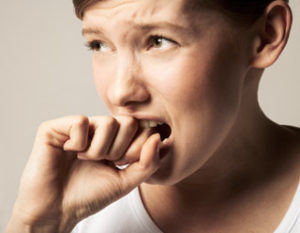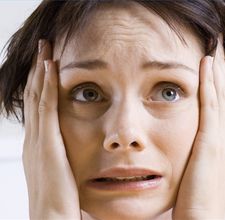 Panic attacks may be symptoms of an anxiety disorder and are a serious health problem in the U.S. At least 20% of adult Americans, or about 60 million people, will suffer from panic attacks at some point in their lives.
Panic attacks may be symptoms of an anxiety disorder and are a serious health problem in the U.S. At least 20% of adult Americans, or about 60 million people, will suffer from panic attacks at some point in their lives.
About 1.7% of adult Americans, or about 3 million people, will have full-blown panic disorder at some time in their lives, twice as often for women than men. The peak age at which people have their first panic attack (onset) is 15-19 years. Another fact about panic is that this symptom is strikingly different from other types of anxiety; panic attacks are so very sudden and often unexpected, appear to be unprovoked, and are often disabling.
Childhood panic disorder facts include that about 0.7% of children suffer from panic disorder or generalized anxiety disorder and that although panic is found to occur twice as often in women compared to men, boys and girls tend to experience this disorder at an equal frequency.
Once someone has had a panic attack, for example, while driving, shopping in a crowded store, or riding in an elevator, he or she may develop irrational fears, called phobias, about these situations and begin to avoid them. Eventually, the pattern of avoidance and level of anxiety about another attack may reach the point at which the mere idea of engaging in the activities that preceded the first panic attack triggers future panic attacks, resulting in the individual with panic disorder being unable to drive or even step out of the house. At this stage, the person is said to have panic disorder with agoraphobia. Thus, there are two types of panic disorder, panic disorder with or without agoraphobia. Like other major illnesses, panic disorder can have a serious impact on a person’s daily life unless the individual receives effective treatment. Panic attacks in children may result in the child’s grades declining, avoiding school and other separations from parents, as well as substance abuse, depression, and suicidal thoughts, plans, and/or actions.
 What are panic attack symptoms and signs in adults, teenagers, and children? As described in the first example above, the symptoms of a panic attack appear suddenly, without any apparent cause. They may include:
What are panic attack symptoms and signs in adults, teenagers, and children? As described in the first example above, the symptoms of a panic attack appear suddenly, without any apparent cause. They may include:
- racing or pounding heartbeat (palpitations); chest pains;
- stomach upset; dizziness, lightheadedness, nausea;
- difficulty breathing, a sense of feeling smothered;
- tingling or numbness in the hands; hot flashes or chills; trembling and shaking;
- dreamlike sensations or perceptual distortions;
- terror, a sense that something unimaginably horrible is about to occur and one is powerless to prevent it; a need to escape;
- nervousness about the possibility of losing control and doing something embarrassing;
- fear of dying
Although the duration of a panic attack can vary greatly, it typically lasts for more than 10 minutes, is one of the most distressing conditions that a person can experience, and its symptoms can closely mimic those of a heart attack. Typically, most people who have one attack will have others, and when someone has repeated attacks with no other apparent physical or emotional cause, or feels severe anxiety about having another attack, he or she is said to have panic disorder. A number of other emotional problems can have panic attacks as a symptom. Some of these illnesses include posttraumatic stress disorder (PTSD), schizophrenia, and intoxication or withdrawal from certain drugs of abuse.
